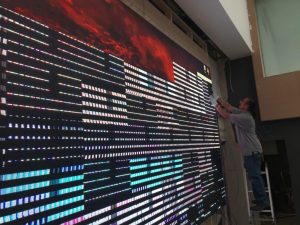How Do Video Walls Work?

Video walls are a collection of LCD or LED screens, mounted together, showing one big image or video across them all – acting like single large screen. As the technology for this develops, becoming cheaper and more accessible, we are starting to see a digital takeover from traditional print signage. The displays, however, are just a small piece of a larger puzzle. In this article we’re going to cover the components of a full video wall system, and how they all link together.
Displays
Large video walls are made up of a number of smaller displays. LCD used to be the most common kind of screen used to create a video wall, but with technology advancing, and production of better technology becoming easier, LED screens are beginning to come into fruition. LED screens produce better quality, brighter images and video content while simultaneously using less energy than an LCD alternative.
There are many benefits to creating a video wall from multiple displays rather than one large display. Due to manufacturing costs, having multiple smaller displays is usually much cheaper than having one large display, especially when you start considering things like pixel density over the whole size of the video wall. Having multiple displays also allows you to create custom tile layouts that you just wouldn’t be able to achieve with a single, large screen.
Controller
The controller’s job is to take a large image then split it up into the correct sizes and sections to display across multiple outputs, each individual screen displays a part of the image to make the whole display wall look like one large screen. There are a few different types of controller available, and they each have their own benefits such as refresh rates, edge masking and rotation capabilities. Some high-end video wall controllers can negate the need for additional software to process and display content.
Software
Video wall software creates a user interface for setting up and managing your controller and displays. There are a range of different levels of software from basic programs to more advanced software with additional features. Basic software allows users to select the content they wish to display in real time, and usually include a few basic tools for editing, such as brightness/contrast of the content, scaling, trimming and resizing. The more advanced software can include features to create full presentation sequences, with options to adjust timing, transitions and labels.
Our Solutions
At Clear VC, we’re experts in all aspects of digital signage. We partner with the technology companies that are shaping the industry to provide a complete service, from design, through installation, to ongoing training and support for your new system. If you’re interested in exploring our video wall and digital signage solutions, give us a call on 0800 368 7358 or click here to book a free demonstration.

